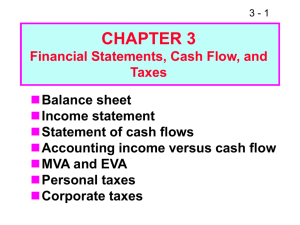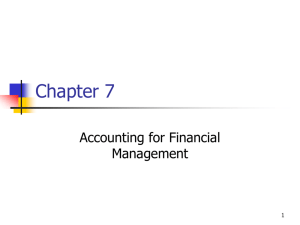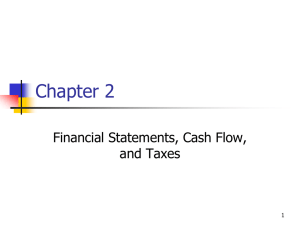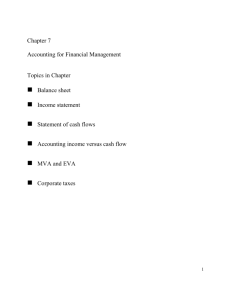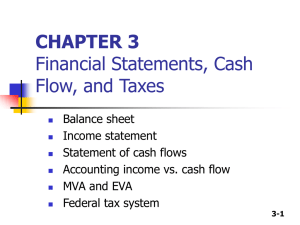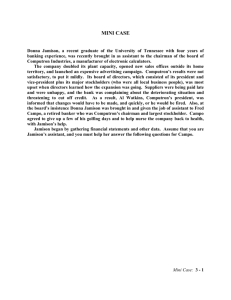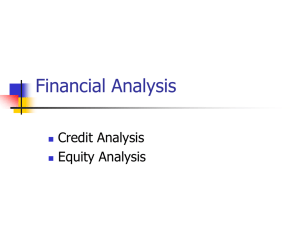Chapter 2 - Dr. Leng Ling
advertisement
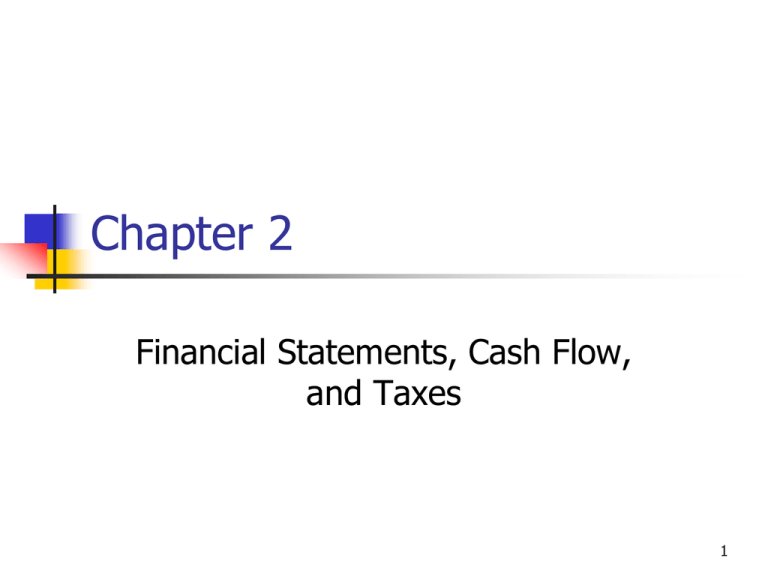
Chapter 2 Financial Statements, Cash Flow, and Taxes 1 Topics in Chapter Balance sheet Income statement Statement of cash flows Free cash flow MVA and EVA Corporate taxes 2 Importance of Financial Statements Form the basis for understanding the financial position of a business Provide information regarding the financial policies and strategies and insight into future performance 10-K and 10-Q 3 Balance Sheet Assets Liabilities and Equity Cash and equivalents Short-term investments (stocks and bonds) Accounts Receivable Inventories Total current assets Accounts payable Notest payable Current long-term debt Accruals Total current liabilities Net plant and equipment Intangible assets (R&D, patents) Long-term investments (stock and bonds) Total Assets Long-term debt Total liabilities Preferred stock Common stock Retained earnings Total Liabilities and Equity 4 Balance Sheet: Assets Cash S-T invest. AR Inventories Total CA Gross FA Less: Depr. Net FA Total assets 2009 $ 9,000 48,600 351,200 715,200 1,124,000 491,000 146,200 344,800 $1,468,800 2010 $ 7,282 20,000 632,160 1,287,360 1,946,802 1,202,950 263,160 939,790 $2,886,592 5 Balance Sheet: Liabilities & Equity Accts. payable Notes payable Accruals Total CL Long-term debt Common stock Ret. earnings Total equity Total L&E 2009 $ 145,600 200,000 136,000 481,600 323,432 460,000 203,768 663,768 $1,468,800 2010 $ 324,000 720,000 284,960 1,328,960 1,000,000 460,000 97,632 557,632 $2,886,592 6 Changes on liabilities & equity CL increased as creditors and suppliers “financed” part of the expansion. Long-term debt increased to help finance the expansion. The company didn’t issue any stock. Retained earnings fell, due to the year’s negative net income and dividend payment. 7 Dell’s Balance Sheet http://finance.yahoo.com/q/bs?s=DELL +Balance+Sheet&ann 8 Balance Sheet highlights Net plant and equipment= gross plant and equipment– accumulated depreciation Common stock at par and additional paid-in (capital surplus) Retained earnings Annual addition to retained earnings = net income – dividends paid Net worth – common equity 9 Income Statement Net Sales Less Cost of Goods Sold (COGS) Less Operating expenses EBITDA Less Depreciation Less Amortizations EBIT Less Interest EBT Less Taxes Net income 10 Income Statement Example 2009 2010 Sales $3,432,000 $5,834,400 COGS 2,864,000 4,980,000 340,000 720,000 18,900 116,960 3,222,900 5,816,960 209,100 17,440 62,500 176,000 146,600 (158,560) 58,640 (63,424) 87,960 ($ 95,136) Other expenses Deprec. Tot. op. costs EBIT Int. expense EBT Taxes (40%) Net income $ 11 Dell’s Income Statement http://finance.yahoo.com/q/is?s=DELL+ Income+Statement&annual 12 MicroDrive Income Statement Table 2-2 MicroDrive Income Statements for Years Ending December 31 (in millions of dollars) 2010 2009 Net sales $3,000.0 $2,850.0 Operating costs except depreciation $2,616.2 $2,497.0 $383.8 $353.0 Depreciation $100.0 $90.0 Amortization $0.0 $0.0 Depreciation and amortization $100.0 $90.0 Earnings before interest and taxes (EBIT) $283.8 $263.0 INCOME STATEMENT Earnings before interest, taxes, deprn., and amortization (EBITDA)* Less interest $88.0 $60.0 $195.8 $203.0 $78.3 $81.2 $117.5 $121.8 $4.0 $4.0 $113.5 $117.8 Common dividends $57.5 $53.0 Addition to retained earnings $56.0 $64.8 Earnings before taxes (EBT) Taxes Net Income before preferred dividends Preferred dividends Net Income available to common stockholders *MicroDrive has no amortization charges. 13 Income Statement Highlight Operating expenses Include management salaries, advertising expenditures, repairs & maintenance, R&D, general & administrative expenses, lease payments, etc. Earnings per common share (EPS) Companies that issued convertible securities (such as bonds convertible into common stock) and stock options, must calculate two types of earnings per share: basic and diluted. 14 Statement of Cash Flows Provides information about cash inflows and outflows during an accounting period Focuses on CASH. Has THREE sections: Cash flow from Operating Activities (OCF) Cash flow from Investing Activities (ICF) Cash flow from Financing Activities (FCF ) 15 Compute the changes in some accounts over two periods Accounts receivables Which goes Notes payable account item Depreciation Fixed assets Accruals etc … to Operating Investing Which section Financing ? 16 Useful Tip 1 No matter which section you are doing (operating, investing or financing), IF the change of an account leads to a cash INFLOW, you add that change (+); IF the change leads to a cash OUTFLOW, you subtract that change (-) inflow: decreases in assets or increases in liabilities or equity. outflow: increases in assets or decreases in liabilities or equity. 17 Useful Tip 2 Cash flow from Operating Activities + Cash flow from Investing Activities + Cash flow from Financing Activities = CHANGE in cash account 18 Cash flows from operating activities 1 Net income + depreciation +/- change in A/R +/- change in Inv. +/- change in A/P +/- change in Accruals 19 Cash flows from operating activities 2 Asset Liability Decreases Add + (cash inflow) Subtract (cash outflow) Increases Subtract (cash outflow) Add + (cash inflow) 20 Cash flows from investing activities 1 Investing activities: Buying or selling productive assets (plant & equipment) Buying or selling financial securities (e.g., stocks and bonds of other companies,) 21 Cash flows from investing activities 2 Inflows: Means: Decrease in gross fixed assets Firm sells long-lived assets such as gross property, plant and equipment Decrease in long-term investments Firm sells debt or equity securities of other firms Outflows: Increase in gross fixed assets Firm buys long-lived assets such as gross property, plant and equipment Increase in long-term investments Firm buys debt or equity securities of other firms 22 Cash flows from investing activities 3 Warning: we want changes in GROSS fixed assets. We don’t want the changes in net fixed assets! BUT, if gross fixed assets are not reported in balance sheet … 23 Cash flows from investing activities 4 change in gross fixed assets = change in net fixed assets + depreciation 24 Cash flows from financing activities 1 +/- changes in N/P +/- changes in current long-term debt +/- changes in long-term debt +/- changes in common and preferred stock +/- changes in capital surplus - Payment of dividends 25 Cash flows from financing activities 2 Inflows: Means: •increase in notes payable •increase in long-term debt •increase in common stock Outflows: Firm borrows money •decrease in notes payable •decrease in long-term debt •decrease in common stock Firm repays debt •Payment of dividends Firm sells equity securities Firm buys back shares Firm pays cash to shareholders 26 Cash Flows Workshop Solve Assignment 3.1 27 Dell’s Statement of Cash Flow http://finance.yahoo.com/q/cf?s=DELL +Cash+Flow&annual 28 Analyzing Statement of Cash Flows 1 Statement of CF can help you analyze a company: 1) Relationship between net income and net cash flow from operations (OCF) If net income positive, but OCF is negative, could mean: Company is growing rapidly Financial mis-management 29 Analyzing Statement of Cash Flows 2 2) Net cash flow from investing activities (ICF) If negative, company is making investments Buying plant & equipment (improve efficiencies) Buying another company’s stock (strategic reasons, e.g., joint venture) If positive, company is liquidating assets. Why? Financial distress? 30 Analyzing Statement of Cash Flows 3 3) Does company have sufficient cash to pay dividends? OCF should exceed dividends. If dividends exceed OCF, why? Company liquidated assets to pay dividends? Company issued equity or borrow to pay dividends? Neither situation is good. 31 Analyzing Statement of Cash Flows 4 4) Changes in debt Look at cash flow from financing activities substantial increases in debt (either short-term or long-term) Substituting short-term debt for longterm debt may indicate worsening financial health. 32 What is free cash flow (FCF)? Why is it important? FCF is the amount of cash available from operations for distribution to all investors (including stockholders and debtholders) after making the necessary investments to support operations. A company’s value depends on the future FCF it can generate. 33 What are the five uses of FCF? 1. 2. 3. 4. 5. Pay interest on debt. Pay back principal on debt. Pay dividends. Buy back stock (repurchase). Buy nonoperating assets (e.g., marketable securities, investments in other companies, etc.) 34 Calculating Free Cash Flow in 5 Easy Steps Step 1 Step 2 Earning before interest and taxes Operating current assets X (1 − Tax rate) − Operating current liabilities Net operating profit after taxes Net operating working capital Step 3 Net operating working capital + Operating long-term assets Total net operating capital Step 5 Step 4 Net operating profit after taxes Total net operating capital this year − Net investment in operating capital − Total net operating capital last year Free cash flow Net investment in operating capital 35 Step1: Net Operating Profit after Taxes (NOPAT) NOPAT = EBIT(1 - Tax rate) =EBIT - Tax 36 Step2: Net Operating Working Capital (NOWC) NOWC = Operating CA Operating CL Operating CA = cash and equivalent + inventory + accounts receivables. Operating CL = accounts payable + accruals 37 Step 3: Total net operating capital (or operating capital) Operating Capital = NOWC + Net fixed assets. 38 Step 4: net investment in operating capital Net investment in operating capital = operating capital this year - operating capital last year 39 Step 5: Free Cash Flow (FCF) FCF = NOPAT - Net investment in operating capital Equation (2-6) 40 Alternative FCF equation (2-9) FCF = operating cash flow - gross investment in long-term operating asset - investment in NOWC Equation (2-9) 41 Is a negative FCF bad? If –NOPAT leads to a –FCF, then bad. High growth usually causes negative FCF (due to investment in capital), but that’s ok if ROIC > WACC. ROIC: return on invested capital ROIC = NOPAT / operating capital 42 Market Value Added (MVA) MVA = Market Value of the Firm - Book Value of the Firm Market Value = (# shares of stock)(price per share) + Value of debt Book Value = Total common equity + Value of debt 43 MVA (Continued) If the market value of debt is close to the book value of debt, then MVA = Market value of equity – book value of equity This applies when it is hard to find the market value of debt. 44 MVA (Assume market value of debt = book value of debt.) Market Value of Equity 2010: Book Value of Equity 2010: (100,000)($6.00) = $600,000. $557,632. MVA = $600,000 - $557,632 = $42,368. 45 Economic Value Added (EVA) EVA = NOPAT – Operating capital x WACC = Operating capital x ROIC – Operating capital x WACC = Operating capital (ROIC-WACC) 46 MVA and EVA (Table 2-5) Table 2-5 MVA and EVA for MicroDrive (Millions of Dollars) 2010 2009 $23.0 $26.0 50.0 50.0 $1,150.0 $1,300.0 Book value of equity $896.0 $840.0 MVA = Market value - Book value $254.0 $460.0 $283.8 $263.0 40% 40% $170.3 $157.8 $1,800.0 $1,455.0 Weighted average cost of capital, WACC (%) 11.0% 10.8% Dollar cost of capital = Operating capital (WACC) $198.0 $157.1 EVA = NOPAT – Capital cost -$27.7 $0.7 ROIC = NOPAT/Operating capital 9.46% 10.85% -1.54% 0.05% -$27.7 $0.7 MVA Calculation Price per share Number of shares (millions) Market value of equity = Share price (number of shares) EVA Calculation EBIT Tax rate NOPAT = EBIT (1-T) Total investor-supplied operating capitala ROIC – Cost of capital = ROIC – WACC EVA = (Operating capital)(ROIC – WACC) 47 2009 Corporate Tax Rates Taxable Income 0 -50,000 50,000 - 75,000 75,000 - 100,000 Tax on Base 0 7,500 13,750 100,000 - 335,000 335,000 - 10M 10M - 15M 22,250 113,900 3,400,000 15M - 18.3M 18.3M and up 5,150,000 6,416,667 Rate on amount above base 15% 25% 34% 39% 34% 35% 38% 35% 48 Features of Corporate Taxation Progressive rate up until $18.3 million taxable income. Below $18.3 million, the marginal rate is not equal to the average rate. Above $18.3 million, the marginal rate and the average rate are 35%. 49 After Chapter Homework Problems: (2-3), (2-4), (2-5), (2-10), (2-12 abcde), mini case d,e,f,g,h. Course website: Statement of Cash Flow assignment 3.2, 3.3. 50
